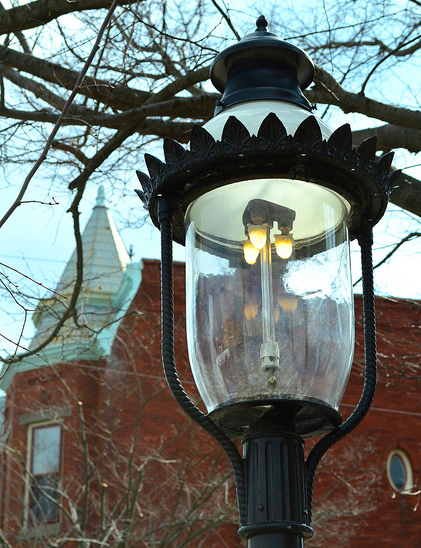RECENT COMMENTS
JessOfRVA on then it happens to you...
Becky Metzler on Updated! Guess what's happening on Mosby/Venable?
Mary on then it happens to you...
Sid on then it happens to you...
Becky Metzler on Church Hill Startup Tackles Insurance for Freelancers
Neighbor on then it happens to you...
Dan Rooney on then it happens to you...

What do you know about the streetlights?
02/23/2015 9:19 AM by John M
A reader is curious about the gas lamps in the St.John’s area: Are they original? When do they date from?
TAGGED: question






What does anyone know about PJ Pink? I am an admirer of her (his?) work, whether its the ornamental architectural detail currently at the top of PJ’s Flickr stream, the foodie shots, or the Richmond cityscapes. It’s all really great.
I don’t know anything about their history, but I wish they would replace the faux lantern lighting (like we see on 25th Street north of Broad) in the rest of Church Hill with this kind of gas lighting. They give such a nice light and they are so much more attractive. Really adds to the historic character. Probably astronomically expensive to do, though.
They were installed in the mid to late 1970’s under the lead of Historic Richmond Foundation. They had begun the restoration of Church Hill in the 50’s with the restoration of the “Pilot Block”, the 2300 block of Grace St. At the same time the streets were resurfaced in the brown small pea gravel that is still there. The city repaves the streets periodically, though it hasn’t happened since the late 1980’s, that I remember. Another interesting story is the iron fencing along N. 22nd St. around the Harwood Mansion at 2200 E. Grace. It was originally in Byrd Park (not sure where), but I know that that is where it came from. It was also about that time that Doug Fleet bought the row at 2218 E. Grace St. (the 2300 Club) and restored it for the club. The club moved from 2300 E. Broad St. to the current site in 1974. He and Elizabeth Bocock moved the houses at 2608 and 2610 E. Franklin and 2515 E. Grace St. from the site of the downtown Public Library in 1972. I guess I digressed a little bit from the street lights, but it all seemed to happen at about the same time.
Hey Bill — I think they use that pea gravel every time the resurface any of the existing pea gravel roads.
As much as I love the look of the old gas lamps, they are horrifically energy-inefficient. We’re talking like 50x more energy used than modern LED lighting.
http://arencambre.com/blog/2005/10/29/gas-lamps-are-expensive/
Worth keeping a few token places for the museum factor, but not a good solution in the long term for street lighting.
Frequent, low-intensity, low height, downward facing LED lights are the way to go for energy usage and for ambiance.
Yea who pays this gas bill? The city and our taxes?
I bet the gas for those adds up! The should divy the bill to those in libby hill park who actually have them….
Historic districts (& their streetscapes) aren’t about energy efficiency – architectural preservation/conservation takes precedence over current trends. If things were replaced when they became outdated or inefficient, CH would be just another subdivision.
#6 — are you even sure the bill for a gas light is less than that of an electric one?
sorry, meant to say more than, not less than
Hi Gerry! Thanks for the photo mention. I really enjoy taking photos in and around RVA. It’s definitely a labor of love.
A reader sent in a pointer to the Edith Shelton photos at the Valentine from the 1950s, with no gas lights http://collections.richmondhistorycenter.com/info.php?s=edith+shelton&type=all&t=objects
The gas lights are nice to have when the power went out, that was for sure. They are subject to a lot more maintenance than normal lights, though.
The original idea was that the house the light was in front of would pay the bill. Last I checked the provision is still in the code.
As I have driven around since this post went up I just realized this style of gas lighting is not exclusive to Church Hill. Saw some near VCU yesterday and some near Byrd Park.
RE: Another interesting story is the iron fencing along N. 22nd St. around the Harwood Mansion at 2200 E. Grace. It was originally in Byrd Park (not sure where), but I know that that is where it came from.
Bill, I think this high fencing from Byrd Park was around the reservoir the south end of the Boulevard. up from the Pump House at the canal. Spacing so wide that childdren could pass through th emetal ‘pickets’.
Im pretty sure the first of the “new” gas lamps were installed in the late 1950s or early 60s… back when HRF was reclaiming and renovating the pilot block (2300 block of Grace Street). They also got the power lines put underground– back before Virginia Power became Dominion– a wonderful thing that has been a real boon, preventing power losses on many occasions.